BIO
Mr. William Sonneborn is President of Generate Capital. Before joining Generate Capital, he was the Senior Director at International Finance Corporation, overseeing investments in Disruptive Technologies, Creative Industries and Funds and on IFC’s management committee.
Prior to joining IFC, he was the President of EIG, a leading energy and infrastructure investment firm, and a member of its Investment and Executive Committees. Prior to joining EIG, he was a partner of Kohlberg Kravis Roberts & Co. and a member of KKR’s Management Committee. William served as CEO of KKR Asset Management as well as CEO and Director of KKR Financial Corporation, a publicly traded specialty finance firm. He also sat on the board of Nephila Capital, a $10 billion hedge fund that is one of the largest private tech-enabled reinsurance vehicles in the world. Prior to joining KKR, he was with the global investment firm TCW Group, Inc., most recently as President and Chief Operating Officer. Previously, he worked at Goldman, Sachs & Co. in New York and Hong Kong, where he focused on mergers & acquisitions. Mr. Sonneborn is a frequent speaker on sustainable infrastructure and technology opportunities. He has given keynote presentations at conferences such as Vivatech, CES, the Global Private Capital Conference and SuperReturn and has appeared on television, radio and in print on venues such as Bloomberg, CNBC, France24, The Financial Times, the Wall Street Journal and PEI. William graduated with honors from Georgetown University. He is involved with a variety of non-profit organizations, serving as a director or trustee of Georgetown University, Georgetown University Entrepreneurship Initiative, Lucile Packard Foundation for Children’s Health at Stanford University, the Global Private Capital Association and Chairman of the board of St. Albans School in Washington, DC.
How our latest investment will help mobilize the green steel market, by Bill Sonneborn
The latest data behind the energy transition
A roundup of energy transition policy headlines
Our favorite articles and reports from the last month
Welcome to the February edition of the Generate: Intelligence newsletter.
Expert view

By the numbers
Infrastructure investor sentiment
As covered in our December and January expert views, 2024 was a challenging year for private market fundraising. Total capital raised for unlisted, closed-end infra funds in 2024 was $91.6 billion, the first time since 2015 that the year-end figure was sub-$100 billion. It’s early days but there are signs of a returning appetite and momentum as we roll into 2025. What’s more, energy transition and climate remain popular themes according to Infrastructure Investor’s 2025 Perspectives report (link).
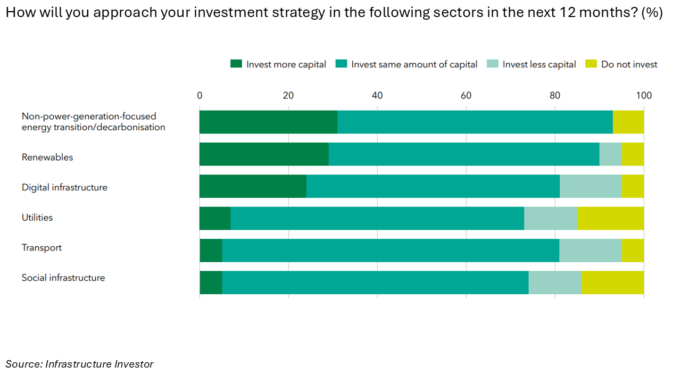
Corporates commit to clean power
Corporates in the US procured more renewable energy in 2024 than ever according to a new report from BNEF and the Business Council for Sustainability (link). Some 28 GW of corporate PPAs were announced in the US in 2024. Technology companies led the way but a record 184 deals were signed in the market from 64 different offtakers.

Life in PJM is complicated
FERC approved PJM’s request to include renewables in capacity auctions (NPM 🔒). This was generally opposed by renewable energy developers who see little financial upside under the current auction design and the real threat of penalties. Earlier in the month, FERC also approved PJM’s Reliability Resource Initiative which aims to fast track “high-reliability projects.” This was not a shoe-in and the commissioners expressed reservations about whether the proposal would actually work (NPM 🔒, Canary Media). Next up… MISO’s Expected Resource Addition Study plan? (NPM 🔒).
PJM is also seeking approval for an unforced capacity cap and floor price range from $175/MW-day to $425/MW-day. These changes come on top of growing discontent from blue state governors about the capacity auction design and PJM’s oversight (Energy Institute Blog). There is around 220 GW of operational power generation capacity in PJM. What gets built and what gets retired in PJM matters a lot to the broader US emissions trajectory. Of the 140 or so gigawatts of fossil capacity with a disclosed heat rate, there’s a wide range of emissions intensity.
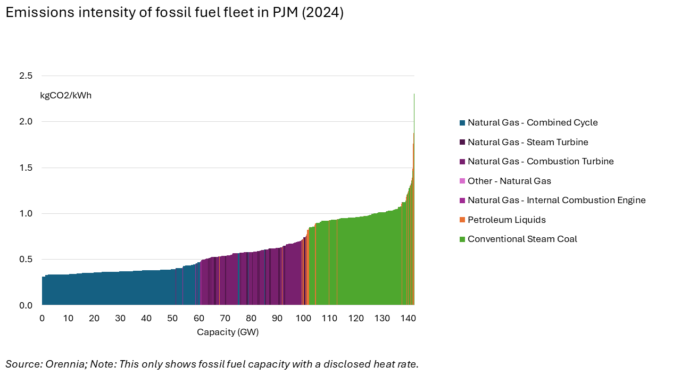
Battery soars, and it’s not all plain sailing for gas in Texas
Recent developments in Texas demonstrate that load growth remains tricky to meet with gas: some 20% of gas capacity in the Texas Energy Fund awarded in 2024 has since dropped or been rejected (Latitude Media) though US gas capacity is growing overall (GEM). Long lead times for key equipment, a tight supply chain, and expected payback closer to four years than 20 are all putting upward pressure on costs (link). Meanwhile, battery capacity continues to grow in ERCOT, with nearly 8,000 MW of battery capacity coming online in the last five years (see below). Texas Renewables’ latest analysis shows the economic impact of renewable energy and energy storage investments across Texas (link).
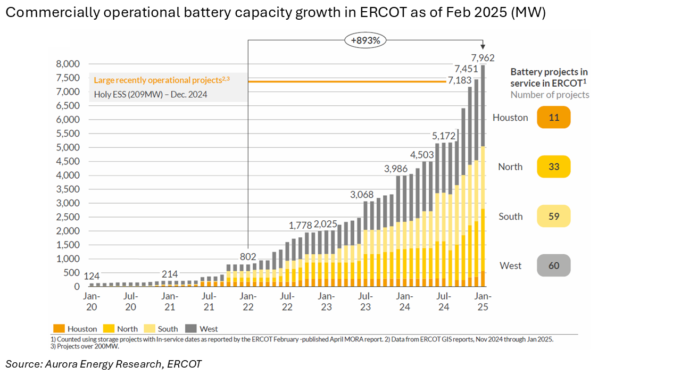
US clean investment continues to grow, but slowly
As the US election season came to a climax and the Biden administration moved to finalize tax credit guidance and obligate IRA loans, US clean energy and transportation investment in Q4 2024 reached $70 billion, a 6% increase from Q4 2023. Total clean investment increased 16% YoY in 2024 to $272 billion. Though overall investment is continuing to grow, these figures reveal a deceleration compared to previous quarter-on-quarter growth (Clean Investment Monitor).

A diverse, and large, tax credit market
2024 feels like a long time ago, but it always takes time for full-year numbers to be finalized. The 2024 tax credit transfer market exceeded Crux’s forecast for total deal volume, more than tripling 2023 transaction volume to total nearly $30 billion. Current-year (2024) tax credit sales made up an estimated $24 billion, and forward-market (2025 or later) sales contributed an additional $6 billion in deal volume. Advanced manufacturing accounted for 34% of the 2024 tax credit market (Crux).
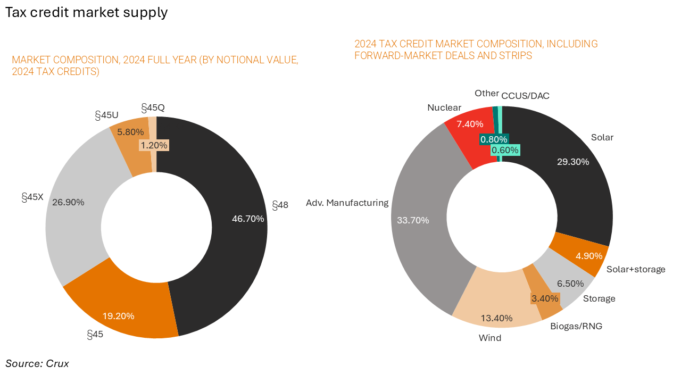
Resolving affordability issues unlocks decarbonization
Pulling from Ember data, Hannah Ritchie has some clean and interactive charts on US state-by-state electricity sources (link) and prices (link). She pairs the two to conclude that despite California being the poster child of high prices, there’s a weak link between renewables and high consumer prices (link). Nonetheless, and this is a drum we will continue to bang, affordability remains a major headwind and threat to the energy transition. For example, the cost per kilometer of PG&E’s EV2-A off-peak rate is now higher than the cost of gasoline (albeit with a European-level vehicle efficiency assumption). There are many affordability solutions — and clean power is well-placed to address affordability compared to fossil fuels — but this should remain a focus of the energy transition (The Power Line).
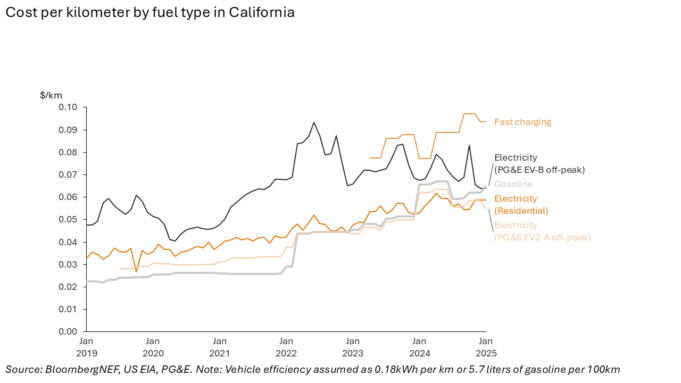
Policy & regulatory highlights
Trade tensions & tariffs
The first full month of Trump’s presidency brought plenty of tariff announcements, though it’s too early to fully separate noise from policy and negotiation tactics from durable tariffs. So far, the Trump administration enacted a 25% tariff on steel and aluminum products (WSJ) and a 10% tariff on all goods from China (AP). More tariff threats loom, including those on auto imports and chips (Electrive) as well as goods – including energy – from Canada and Mexico which were subsequently paused and, as of now, are scheduled to take effect next week (NYT 🔒, Utility Dive, PoliticoPro 🔒).
Clean energy funding freezes
The Trump administration lifted its Day One pause on disbursements of some IRA and infrastructure law funds (Politico 🔒), though the fate of obligated federal clean energy funding remains unclear in some cases. While the Loan Programs Office made true on its promise to begin disbursing funds with its loan to Montana Renewables (PoliticoPro🔒), the confusion is playing out in real time over grants from the EPA’s Greenhouse Gas Reduction Fund (GGRF). New EPA head Lee Zeldin ordered Citibank to return the $20 billion in GGRF program funds it had been tapped to disburse (Washington Post 🔒, PoliticoPro 🔒), and several grant recipients have said they’re not able to access their funds (E&ENews 🔒, Politico 🔒). Others are moving forward with plans to deploy their funds despite the EPA’s attempts to claw them back (Politico 🔒).
The end to an independent FERC?
A new executive order requires FERC to submit “significant regulatory actions” to the Trump administration for review. Time will tell what this means for the energy regulator’s ability to oversee power markets, as well as the in-progress FERC regulations aimed at expanding and strengthening the US electric grid (E&E News, Semafor, PoliticoPro 🔒). The development marks a stark contrast from how independent agencies like FERC have historically been shielded from political influence (LinkedIn).
The pursuit of “energy dominance” picks up
Following the Trump admin’s “energy emergency” declaration last month, the Army Corps of Engineers identified about 600 pending permits for energy and infrastructure projects that could skip typical environmental review processes, though it’s unclear where that effort currently stands (E&E News 🔒, PoliticoPro 🔒). The White House also established a National Energy Dominance Council to advise Trump on strategies for improving processes across “all forms” of American energy (White House). A group of more than 100 businesses and industry organizations borrowed Trump’s rhetoric in a letter to Congressional leaders, arguing that the IRA’s 45V hydrogen tax credit is a key strategy for achieving US energy dominance and advancing American competitiveness in global hydrogen markets (Heatmap 🔒).
A first step toward budget reconciliation
House Republicans passed their budget resolution by a narrow margin earlier this week, taking the first step in moving forward a single bill to address all facets of Trump’s agenda. The resolution tees up the House’s eventual reconciliation bill by instructing House committees on targets for spending cuts and tax changes. This is the first step in a long reconciliation process: House Republicans remain divided over the magnitude of cuts to IRA tax credits, and Senate Republicans, who have been moving forward their own two-bill approach to budget planning, must decide how to reconcile the proposals (NYT 🔒, Politico 🔒).
State & local updates
New York state is investing $60 million in building nearly 270 EV fast chargers across NYC in the next two years via a NY Green Bank loan (link). NYC’s congestion pricing program, meanwhile, is locked in a battle with the Trump administration (Heatmap 🔒). Stay tuned.
A reintroduced bill in California’s legislature would exempt renewable energy developers from paying taxes on revenue from sales of IRA environmental credits. Forty-five other states already do not tax the revenue from IRA credit sales (PoliticoPro 🔒).
SoCal Edison raised electric rates on customers to help pay what it owes to victims of the 2017 Thomas wildfire, which the utility played a role in starting (LA Times).
The largest electric utility in Minnesota will deliver 100% carbon-free electricity by 2035, based on a new plan approved by the state’s energy regulator. Under the plan, Xcel Energy will scale up renewables capacity and extend the lifespan of two nuclear plants, while shutting down coal plants and paring back plans for building new natural gas plants (MN Star Tribune).
What we're reading
A three-hour non-technical video primer on understanding LLMs from first principles (link)
How flexible loads could warrant a partial rethink around load growth (link)
A post from Grid Strategies on modest reductions in load estimates in MISO, PJM, and Georgia Power (link). We covered the initial report in our December expert view (link). Also, Microsoft Dropped Some AI Data Center Leases (link).
A new AI Energy Score (link)
GridLab and Berkely University have teamed up to produce a “From Scarcity to Surplus” dashboard and technical paper (link)
Why America still needs Canadian oil (link), Retaliation – a MAD policy? (link)
Trump’s 2nd Trade War Begins (link)
Dunne Insights on the fate of European automakers (link)
UC-Berkeley resource economist Meredith Fowlie: “To LNG or not to LNG is not the right question” (link). Meanwhile, Europe LNG imports in 2024 fell to an 11-year low (link)
Climate Power Report: The state of the clean energy boom (link)
JP Morgan’s Introduction to Climate Intuition (link)
First Street Report: Climate change is expected to reduce US home values by $1.5 trillion by 2055 (link). On a related note, S&P Global Ratings downgraded the credit rating of the Los Angeles water and power utility in a shock to the system for the $4 trillion municipal bond market (link 🔒).
IEA 2025 electricity demand outlook (link)
Power Moves: How Electric Utility Monopolists Broke Their Bargain with America (link)
A data-driven deep dive into US interconnection queues (link)
Regional Transmission Organizations as Market Platforms IV (link)
The Ohio Chamber of Commerce emerges as solar’s unlikely ally (link)
What the laws of physics tell us about CO2 removal (link)
The first episode of SOSV’s Deep Tech Live series: “What now? From the IRA to Drill, baby, drill” (link)
More newsletters
October 2025 Newsletter
Trade policy and House tax bill implications, and more US energy and infrastructure news and analysis
Read moreSeptember 2025 Newsletter
Reflections on RE+ and Climate Week, the role of private credit, who to blame for high electricity prices and a cool Texas summer.
Read moreAugust 2025 Newsletter
Solar investment figures, PPA wariness, and more US energy and infrastructure news and analysis
Read more